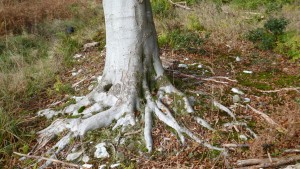 Really great root structure is a difficult concept to get to grips with. Lots of advice can be found about root pruning at all stages of the bonsai life cycle, root grafting to fill in gaps on mature trees, growing trees on tiles in the ground in a developmental stage to spread the roots, etc. That is all well and good but it is essential to keep in mind a natural image that we should be aiming for, like this Beech.
Really great root structure is a difficult concept to get to grips with. Lots of advice can be found about root pruning at all stages of the bonsai life cycle, root grafting to fill in gaps on mature trees, growing trees on tiles in the ground in a developmental stage to spread the roots, etc. That is all well and good but it is essential to keep in mind a natural image that we should be aiming for, like this Beech.
Also a neighbouring tree that blew down in the storms, but beautifully reveals the ramified root structure:
I also collected a few photos of some big old hedgebank beech trees. Hedgebanks are fairly  unique to the Westcountry and involve creating a bank of earth, laying a stone face over it and then planting a hedge on top – very secure against any sort of livestock and offers protection from the wind. Over the years these hedges don’t get cut and the hedge plants grow on to become trees, sometimes very substantial trees. The soil that was the bank slowly erodes over time in the wind and the rain and the roots of the trees become exposed. So we get the chance to see what the root structure should look like in a more 3D view
unique to the Westcountry and involve creating a bank of earth, laying a stone face over it and then planting a hedge on top – very secure against any sort of livestock and offers protection from the wind. Over the years these hedges don’t get cut and the hedge plants grow on to become trees, sometimes very substantial trees. The soil that was the bank slowly erodes over time in the wind and the rain and the roots of the trees become exposed. So we get the chance to see what the root structure should look like in a more 3D view
You can clearly see the roots divide and sub divide as they disappear down into the soil. It is clear there is real strength here holding the tree upright and with a little imagination then the roots could be fingers and knuckles. Some fuse together as they cross and create ever more interesting shapes. We should not be afraid of this in our trees as long as the roots get smaller at further distances from the trunk then they will almost always appear natural.
 One final image shows that to be convincing the stem need to flare before reaching the soil and the division begins well above ground.
One final image shows that to be convincing the stem need to flare before reaching the soil and the division begins well above ground.
To recreate this we need to ensure that there is a balance of growth around the roots and not allow a single root to overdevelop in exactly the same way that we would prune back an overly strong shoot above ground. Some people like to see all roots evenly sized but this is taking an unnatural step as the roots and branches never develop evenly – the top photo is perfect proof of this. The roots should spread and radiate from the trunk so do try to position roots when repotting. If the tree is presenting an image where it has been exposed to the elements the always try to show a little root on the surface of the soil as the weather will certainly have been eroding the soil, but a mature spreading parkland tree should really keep the roots hidden as over time the soil level will rise upwards through deposition of organic matter over centuries, following this tip will keep the image consistent and convincing.
Considering all of the above take a look at this bonsai and decide for yourself which side of the trunk looks most natural:


